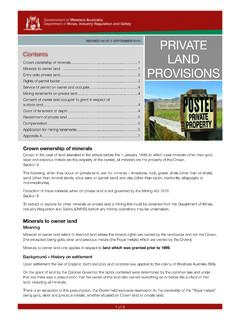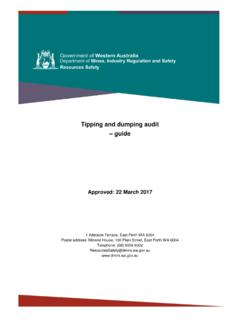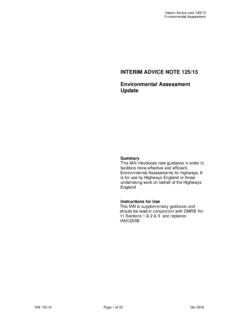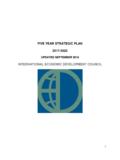Transcription of Ministerial Advisory Panel background Sessions
1 Page 1 of 21 Ministerial Advisory Panel background Sessions Session 1: Overview of DMP s environmental regulation functions Objective To provide background information to the history, role and context of the department s regulatory functions. History The Department of Mines and Petroleum (DMP) has, in various forms, existed since the 1890s. DMP, in its current form was established on 1 January 2009, with the separation of the Department of Industry and Resources (and the Department of Consumer and Employment Protection) into the Department of State Development (DSD), the Department of Commerce, and DMP. DMP is now the State s lead agency in attracting private investment in resources exploration and development through the provision of geoscientific information on minerals and energy resources, and management of an equitable and secure titles systems for the mining, petroleum and geothermal industries.
2 It also carries prime responsibility for regulating these extractive industries and dangerous goods in Western Australia, including the collection of royalties, and ensuring that safety, health and environmental standards are consistent with relevant State and Commonwealth legislation, regulations and policies. The environmental regulatory function of DMP has evolved into a core function of the department since the early 1980s (when the new Mining Act 1978 allowed specific conditions on mining leases for environmental management). The requirement for secondary approvals following tenure grant were progressively implemented with the Mining Act 1978 (which repealed the Mining Act 1904). While the requirement for a secondary environmental approval on mining tenure has been in place since the commencement of the Mining Act 1978, other secondary environmental approval requirements were variously introduced (both administratively and legislatively) over the following years, for example.
3 The Mining Act 1978 was amended in 1990 to introduce the powers to place conditions on exploration and prospecting tenements to control environmental impacts the specific requirement for Mining Proposals was introduced in 2006, replacing the notice of intent , and in 2010, the specific requirement for Mine Closure Plans was introduced into the Mining Act 1978 from 1999 to 2011, the department administered under delegation environmental regulations for petroleum activities in commonwealth waters Page 2 of 21 the requirement for environmental plans for onshore and offshore petroleum activities was introduced administratively in 1999, with regulations currently under preparation to place this requirement in legislation.
4 Also, from 1990 to 2004, DMP was administering the requirements for assessing native vegetation clearing through a delegation from the Commissioner for Soil and Land Conservations, under the Soil and Land Conservation Act 1945. The environmental Protection Act 1986 was amended in 2004 to introduce the requirements of native vegetation clearing assessment (and remove them from the Soil and Land Conservation Act 1945). On 1 July 2005, DMP was delegated the powers to assess and issue native vegetation clearing permits on mineral and petroleum tenure under the Environment Protection Act 1986. This delegation remains in place. In February 2005, the Environment Division was first formed as a standalone division.
5 The division was staffed through bringing together officers who were working on environmental matters from strategic policy areas of the department, as well as from the Safety, Health and Environment Division, and the Petroleum Division. At that time the division had around 30 officers. Current Role and Function of the Environment Division The principle role of the Environment Division is to promote best practice environmental management by delivering high quality and timely environmental regulatory and policy services. The division works closely with industry to encourage mining and petroleum proponents to participate in best practice methods when exploring for, operating or rehabilitating mining, petroleum, the geological storage of greenhouse gases or geothermal projects.
6 In order to do this effectively, the division regularly liaises with other key departments including the Department of Environment and Conservation (DEC), the Office of the environmental Protection Authority (OEPA), Department of Water (DoW) and the Department of Indigenous Affairs (DIA). The key roles of the division include: administering the environmental aspects of State mineral and petroleum legislation assessing, auditing and monitoring environmental aspects of mining and petroleum projects providing incident investigation services and initiating the department s enforcement policy as required liaising with core stakeholders and benchmarking the division s performance against customer expectations regulating the provisions of the native vegetation clearing regulations for the resources sector providing strategic policy advice regarding State and Commonwealth environmental initiatives that may affect the regulation of, and access for, the resources sector, including environmental assessment policies, legislation and planning.
7 The Department s Environment Division is also responsible for updating existing and developing new environmental guidelines and policies and publishing these to ensure industry is well informed about correct industry practices. Page 3 of 21 The Division also coordinates the annual Golden Gecko Awards for environmental Excellence which recognises demonstrated leadership and excellence in environmental practices in the mineral and petroleum sector. The Environment Division now has approximately 60 officers employed under the Public Sector Management Act 1994, and another 8-10 contractors. The division has a functional structure within the Approvals Group of the department (Figure 1). Figure 1: Simplified organisational structure DMP Statutory environmental Functions of DMP The majority of the functions of the Environment Division are in regulatory services.
8 While DMP is responsible for the administration of 21 different acts of parliament, the principle functions for the division are in the administration of approvals under: Mining Act 1978 Petroleum Pipelines Act 1969 Petroleum and Geothermal Energy Resources Act 1967 Petroleum (Submerged Lands) Act 1982 environmental Protection Act 1986 (under delegation) These acts establish requirements for operators to obtain approvals, under which the obligations for environmental management (and reporting) are established. There is currently a proposal for specific environmental regulations under the three petroleum Acts to be adopted which will also include statutory environmental obligations in additional to approval conditions. The regulatory activities of the division relate directly to the assessment of proposals under this legislation, and occur as specific approvals as detailed in Table 1.
9 The assessment of proposals is a critically important role for the department as it ensures Director General Richard Sellers Strategic Policy Deputy Director General Michelle Andrews Approvals Deputy Director General Tim Griffin Environment Executive Director Phil Gorey Petroleum Executive Director Bill Tinapple Mineral Titles Executive Director Ivor Roberts Geological Survey Executive Director Rick Rogerson Resources Safety Executive Director Malcom Russell Corporate Support Executive Director Mick Banaszczyk Reform Programs Project Director Simon Skevington Page 4 of 21 that adequate environmental practices are incorporated into the design, and that these practices are clearly established before any operation commences. It is also the process which allows exploration and development to proceed (as these approvals are required by legislation to be issued).
10 Table 1: List of principle regulatory environmental approvals Form of Approval Purpose Governing legislation Annual No. Approved Mining Proposal Authorises mining activities Mining Act 1978 350 Mine Closure Plans Approval for decommissioning of mine site Mining Act 1978 200 Programmes of Work Authorises mineral exploration Mining Act 1978 2500 Native Vegetation Clearing Permit Authorises the clearance of native vegetation for petroleum or mineral activities environmental Protection Act 1986 250 Environment Plans Authorises onshore petroleum or geothermal activities Petroleum and Geothermal Energy Resources Act 1967 100 Environment Plans Authorises offshore petroleum activities in State waters Petroleum Submerged Land Act 1982 50 (Construction and Operational) Environment Plans Authorises the construction and operation of pipelines in State waters or lands Petroleum Pipelines Act 1969 20 Oil Spill Contingency Plans Plans required to accompany any petroleum applications Each of the three petroleum acts listed above 15 The process for assessing proposals warrants individual assessment of the detail of the applications, and each application is required to be.
















